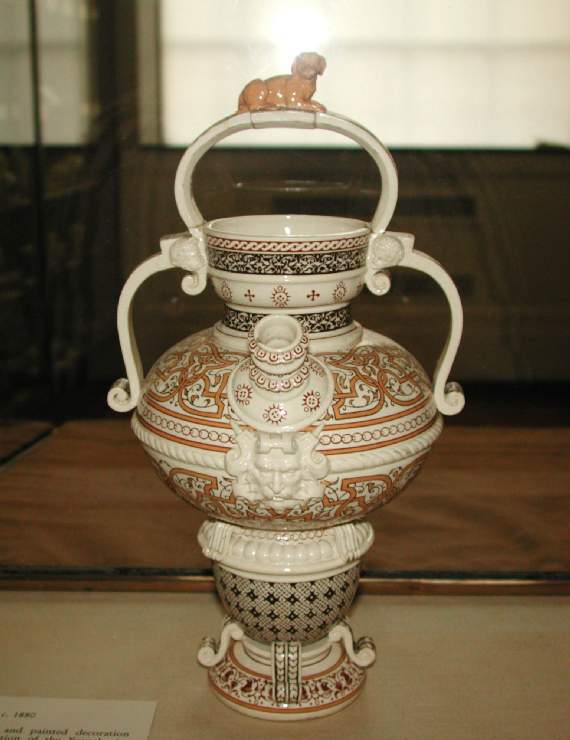Current Location: In storage
Titles
Ewer in ‘Henri II ’ ware
Maker(s)
Factory:
Minton & Co.
Designer:
Arnoux, Joseph Francois Leon
(Possibly)
Decorator:
Toft, Charles
Entities
Categories
Description
Cream earthenware with inlaid pattern of coloured clays, clear glazed.
Gourd-shaped ewer on a domed foot, with raised neck and a round spout which juts from the upper body. Two strap handles rejoin the body at the rim and are then joined by a continuous loop across the top. The surface is covered with incised and inlaid clay patterns, in light and dark brown, which imitate those used on 16th-century ‘Henri II’ or ‘St Porchaire’ ware. A light brown modelled dog sits atop the loop handle and unpainted relief decoration, including a bearded mask, putti and a rope circling the upper body; four incised straps decorate the foot. The underside is recessed, with a small central vent hole.
Notes
History note: Charles & Lavinia Handley Read
Legal notes
Purchased with the Perceval Fund and grant-in-aid from the Victoria and Albert Museum
Measurements and weight
Height: 26.8 cm
Width: 13.8 cm
Acquisition and important dates
Method of acquisition: Bought
by
Stainton, Thomas
Dating
19th Century, Late
Victoria I
1870
CE
-
1880
CE
Note
Minton launched wares ‘coloured in the Majolica style’ at the Great Exhibition of 1851, to great acclaim. The new product took inspiration from Renaissance maiolica, but used brightly coloured lead-glazes and favoured sculptural forms rather than finely painted decoration. The Minton Art Director Léon Arnoux (1816-1902), however, sought to more directly reproduce Renaissance techniques and shapes, and in 1858 produced his first imitation of 16th-century French ‘Henri II’ inlaid earthenware (also known as ‘Saint Porchaire’ ware or ‘Faience d’Oiron’). Many of Arnoux’s designs. Charles Toft Snr. (1832-1909), who later became chief modeller for Wedgwood, specialised in realising this type of decoration during the 1860s-70s, drawing on Delange’s book of all the known examples, published in 1861. Minton continued to offer ‘Henri II’ ware until c.1893.
Only a limited number of pieces was produced, however, and mainly for display. ‘Henri II’ ware was fragile and, as Colin Minton Campbell noted, ‘it is very expensive, from the inlaying of the clays, and the effect is not equal to the cost’ (Jones, 150). The geometric ornamentation was made by pressing metal dies into the unfired surface and then filling the depressions with clay. The relief decorations were moulded and applied. Although unlike Majolica ware in appearance, the glaze used is similar.
Several versions of this example exist, including at the V & A Museum (CIRC.825-1920). These generally have an additional foot-plate and more painting on the relief decoration. The Fitzwilliam Museum also holds an piece of original ‘Henri II’ ware, the lower part of a ewer, c.1540-60 (EC.2-1940).
School or Style
Renaissance Revival
People, subjects and objects depicted
Components of the work
Decoration
composed of
lead-glaze
Materials used in production
Earthenware
Techniques used in production
Moulding
References and bibliographic entries
Related exhibitions
Identification numbers
Accession number: C.43-1972
Primary reference Number: 75074
Stable URI
Audit data
Created: Saturday 6 August 2011
Updated: Tuesday 30 April 2024
Last processed: Monday 4 August 2025
Associated departments & institutions
Owner or interested party:
The Fitzwilliam Museum
Associated department:
Applied Arts





